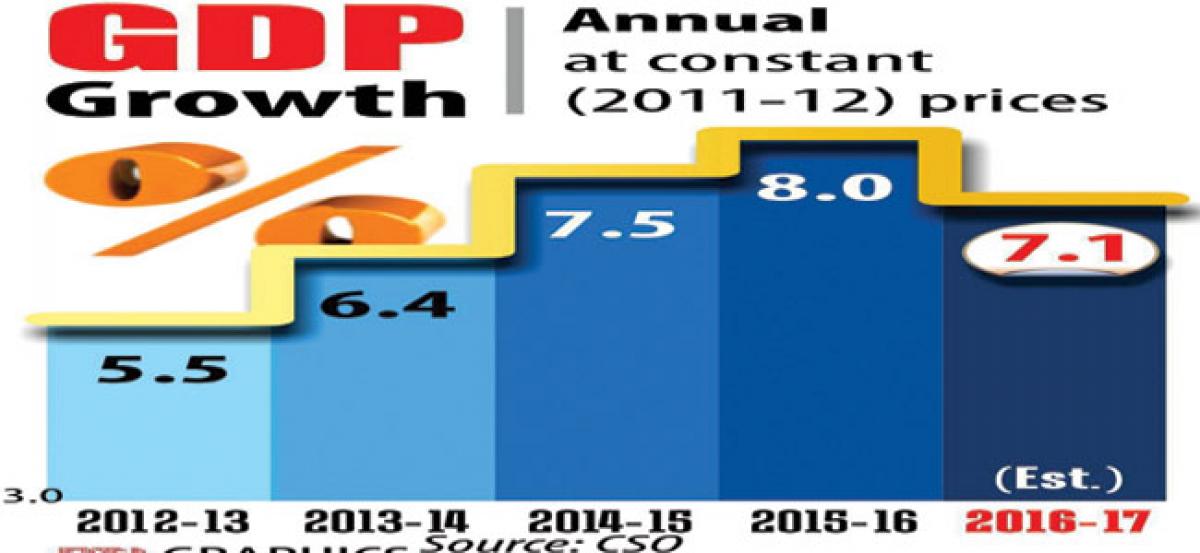Live
- BGT 2024-25: Yash Dayal added to Indian team’s pace bowling reserve list after Khaleel Ahmed gets injured
- Centre urges southern states to fast-track schemes to boost farm sector
- Karnataka government will promote more industries: DCM DK Shivakumar
- Naxal menace has come to stay
- Preeti Tupsakhare Provides Expert Guidance on Integrating Genomic Data into Clinical Workflows, Bridging the Gap Between Genetics and Healthcare IT
- NLC INDIA Limited contributes Rs.1 crore to Kerala disaster mitigation fund
- World Children’s Day 2024: 20 November
- AR Rahman surprises fans with a divorce hashtag
- Keerthy Suresh to get engaged soon!
- CM A. Revanth Reddy Performs Special Rituals In Vemulawada
Just In

Hit hard by demonetisation, India lost the tag of the fastest growing economy to China in the March quarter with a GDP growth of 6.1 per cent, pulling down the 2016-17 expansion to a three-year low of 7.1 per cent. The bad news of the economy growing at the slowest pace in three years mainly on account of poor performance of manufacturing and service sectors come at a time when the Modi government
Registers 7.1% upswing in FY17; India loses fastest-growing tag to China in Q4
New Delhi: Hit hard by demonetisation, India lost the tag of the fastest growing economy to China in the March quarter with a GDP growth of 6.1 per cent, pulling down the 2016-17 expansion to a three-year low of 7.1 per cent. The bad news of the economy growing at the slowest pace in three years mainly on account of poor performance of manufacturing and service sectors come at a time when the Modi government is celebrating three years in office.
Highlights:
- Construction sector takes hard hit with de-growth of 3.7% in Q4
- Growth rate declined in mfg, mining, trade, hotels in FY17
- Agriculture the only bright spot with an impressive 4.9%
The GDP growth in 2016-17 is slowest in two years. It was 8 per cent in 2015-16 and 7.5 per cent in the previous year. The growth for the 2016-17 fiscal has slowed down despite very good showing by the agricultural sector. China had reported a growth of 6.9 per cent in the January-March quarter of 2017. India had for the first time outpaced China in GDP growth rate in 2015.
As per the data released by the Central Statistics Office (CSO), the expansion in Gross Value Added (GVA) during the fourth quarter of 2016-17 fell sharply to 5.6 per cent as compared to 8.7 per cent in the comparable period of 2015-16. For the year as a whole, the expansion in GVA works out to be 6.6 per cent, down from 7.9 per cent a year ago. The GVA has been declining for the five straight quarters since January-March, 2016.
On November 9, 2016, the government had demonetised higher value currency which wiped off about 87 per cent of notes in circulation, leading to a severe cash crunch and disruption in the economic activities. When asked whether note ban has impacted fourth quarter growth, Chief Statistician T C A Anant said a separate analysis is needed, though he admitted that this was one of the dynamics which might have impacted economic performance in third and fourth quarters.
Chief Economic Advisor Arvind Subramanian said demonetisation was a "temporary shock" to the economy and "we are seeing this bottoming out as remonetisation progresses". The construction sector was the hardest hit by demonetisation in the fourth quarter and saw a negative growth of 3.7 per cent during the period as compared to 6 per cent in corresponding three months of 2015-16.
The CSO said the growth rate declined in manufacturing, mining, trade, hotels, transport, communication, services related to broadcasting, financial, real estate and professional services, both in the fourth quarter as well in the entire year. The manufacturing sector GVA growth declined to 7.9 per cent in 2016-17 from 10.8 per cent on yearly basis. The mining and quarrying sector witnessed a sharp deceleration to 1.8 per cent from 10.5 per cent in 2015-16.
The agriculture sector growth, which accelerated to an impressive 4.9 per cent in the last fiscal from a dismal 0.7 per cent a year ago on account of good monsoon, failed to compensate for decline in other sectors of the economy. In the fourth quarter itself, the agriculture sector GVA rose by 5.2 per cent as compared to 1.5 per cent in the same period of 2015-16.
The data further said the per capita income during 2016- 17 is estimated to have attained a level of Rs 1,03,219 as compared to the estimates for the year 2015-16 of Rs 94,130, showing a rise of 9.7 per cent. Gross Fixed Capital Formation (GFCF) (current prices), a barometer of investments, is estimated at Rs 41.18 lakh crore in 2016-17 as against Rs 40.03 lakh crore in 2015-16.

© 2024 Hyderabad Media House Limited/The Hans India. All rights reserved. Powered by hocalwire.com







